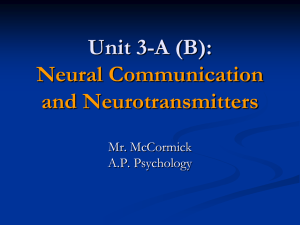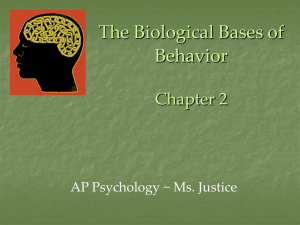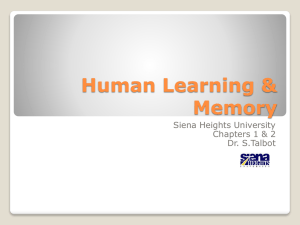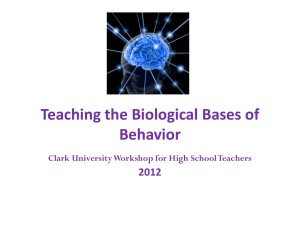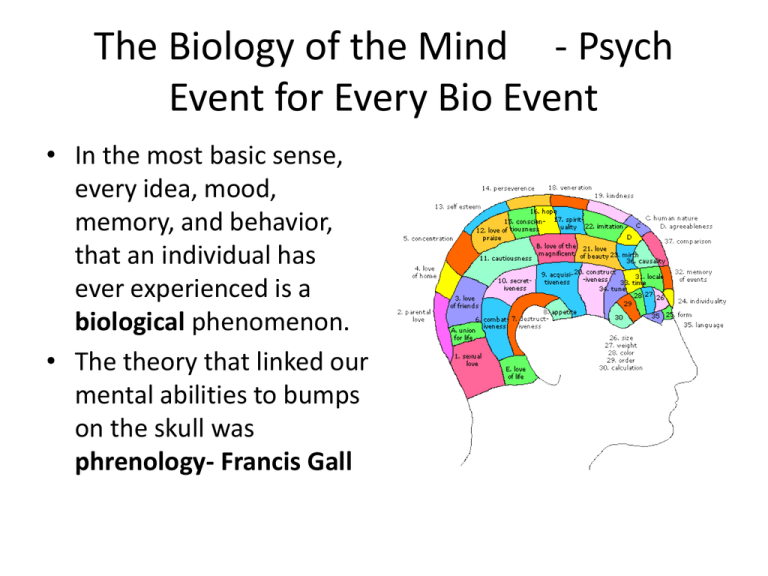
The Biology of the Mind - Psych
Event for Every Bio Event
• In the most basic sense,
every idea, mood,
memory, and behavior,
that an individual has
ever experienced is a
biological phenomenon.
• The theory that linked our
mental abilities to bumps
on the skull was
phrenology- Francis Gall
Biology
• Researchers who study
the links between biology
and behavior are called
biological psychologists.
• We are made up of
smaller and smaller
subsystems; we are also
part of larger systems.
Thus we are
biopsychosocial systems.
Neural Communication
We are a biopsychosocial system.
Cellular Level
(Interconnected
Neurons)
Ethnic Level
(Culture)
Organ Level
(Brain)
Group Level
(Family)
System Level
(Information
Processing)
Individual Level
(Human Being)
Community Level
(Society)
3
Neural Communication
Neurobiologists and other investigators
understand that humans and animals operate
similarly when processing information.
Note the similarities in the above brain regions, which are all
engaged in information processing.
4
Neural Communication
• Our body’s neural system is
built from billions of nerve
cells, or neurons. Info
arriving from brain and
spinal cord from the body
travels in sensory neurons.
Instructions from the brain
and spinal cord are sent to
the body’s tissue via motor
neurons. The neurons that
enable internal
communication within the
brain are called
interneurons.
Neural Communication
• The extensions of a
neuron that receive
messages from other
neurons are the
dendrites. The extension
of a neuron that transmits
info to other neurons is
the axon; some of these
extensions are insulated
by a fatty tissue called the
myelin sheath; which
helps speed the neuron’s
impulses.
Neural Communication
• The neural impulse, or
action potential, is a brief
electrical charge that
travels down an axon. The
fluid interior of a resting
axon carries mostly
negatively charged ions,
while the fluid outside has
mostly positively charged
ions. This polarization,
called the resting
potential, occurs because
the cell membrane is
selectively permeable.
Neural Communication
• An action potential occurs when the first part of the axon opens
its gates and negatively charged ions rush in, causing that part
of the neuron to become depolarized. During the resting pause
following an action potential, called the refractory period, the
neuron pumps positively charged ions back outside the cell.
Depolarization & Hyperpolarization
Depolarization: Depolarization occurs when
positive ions enter the neuron, making it more
prone to firing an action potential.
Hyperpolarization occurs when negative ions
enter the neuron, making it less prone to firing
an action potential.
9
Neural Communication
• To trigger a neural
impulse, excitatory
signals minus inhibitory
signals must exceed a
certain intensity, called
the threshold. Increasing
a stimulus above this level
will NOT increase the
neural impulse’s intensity.
This phenomenon is
called all or none
response.
Neural Communication
• The strength of a
stimulus does NOT
affect the intensity of a
neural impulse. A strong
stimulus can trigger
more neurons to fire.
How nerve cells communicate
• The junction between
two neurons is called a
synapse; and the gap is
called the synaptic
cleft. Discovery was
made by Sir Charles
Sherrington.
How nerve cells communicate
• The chemical messengers
that convey information
across the gaps between
neurons are called
neurotransmitters. These
chemicals bind to
receptor sites and unlock
tiny channels, allowing
electrically charged
atoms to enter the
neuron.
How nerve cells communicate
• Neurotransmitters
influence neurons
either by exciting or
inhibiting their
readiness to fire. Excess
neurotransmitters are
reabsorbed by the
sending neuron in a
process called
reuptake.
How Neurotransmitters Influence Us?
Serotonin pathways are
involved with mood
regulation.
From Mapping the Mind, Rita Carter, © 1989
University of California Press
15
Dopamine Pathways
Dopamine pathways
are involved with
diseases such as
schizophrenia and
Parkinson’s disease.
From Mapping the Mind, Rita Carter, © 1989
University of California Press
16
Neurotransmitters
17
Agonists
18
Antagonists
19
Lock & Key Mechanism
Neurotransmitters bind to the receptors of the
receiving neuron in a key-lock mechanism.
20
How Neurotransmitters Influence
Behavior
• A neurotransmitter that is
important in muscle contraction
is acetylcholine; It is also
important in learning and
memory.
• Naturally occurring opiate like
neurotransmitters that are
present in the brain are called
endorphins. Endorphins help
explain runner’s high, painkilling
effects of acupuncture
• When the brain is flooded with
drugs such as heroin or
morphine. It may stop producing
these neurotransmitters.
How Neurotransmitters Influence
Behavior
• Drugs that produce their
effects by mimicking
neurotransmitters are called
agonists. Drugs that block
the effects of
neurotransmitters by
occupying their receptor
sites are called antagonists.
While certain opiate drugs
create a temporary “high”
by mimicking the
endorphins, the poison
curare produces paralysis by
block the activity of the
neurotransmitter ACh.
The Nervous System
• Taken altogether, the
neurons of the body form
the nervous system. The
brain and spinal cord form
the central nervous system.
The neurons that link the
brain and spinal cord to the
body’s sense receptors,
muscles, and glands form
the peripheral nervous
system.
• Sensory and motor axons
are bundled into electrical
cables called nerves.
The Nervous System
Nervous System: Consists of all the nerve cells. It is
the body’s speedy, electrochemical communication
system.
Central Nervous System (CNS): the brain and
spinal cord.
Peripheral Nervous System (PNS): the sensory and
motor neurons that connect the central nervous
system (CNS) to the rest of the body.
24
The Nervous System
• The division of the
peripheral nervous
system that enables
voluntary control of the
skeletal muscles is the
somatic nervous system.
• Involuntary, self
regulating responsesthose of the glands and
muscles of internal
organs- are controlled by
the autonomic nervous
system.
The Nervous System
• The body is made ready
for action by the
sympathetic division of
the autonomic nervous
system. The
parasympathetic
division of the
autonomic nervous
system produces
relaxation.
The Nervous System
• Neural clusters work into groups called neural
networks.
• Automatic responses to stimuli, called reflexes,
illustrate the work of the spinal cord. Simple
pathways such as these are involved in the knee- jerk
response and in the pain reflex.
Central Nervous System
The Spinal Cord and Reflexes
Simple Reflex
28
The Nervous System
Neurons in the brain
connect with one
another to form networks
Inputs
The brain learns by modifying
certain connections in
response to feedback
Neural Networks
interconnected neural cells
with experience, networks
can learn, as feedback
strengthens or inhibits
connections that produce
certain results
computer simulations of
Outputs neural networks show
analogous learning
Interneurons- brains
internal communication
system- we have billions of
interneurons
Endocrine System
• The body’s chemical
communication is called
the endocrine system.
This system transmits
information through
chemical messengers
called hormones at a
much slower rate than
the nervous system,
and its effects last a
longer time.
Endocrine System
• In a moment of danger,
the ANS orders the
adrenal glands to release
epinephrine and
norepinephrine.
• The most influential gland
is the pituitary, which,
under the control of an
adjacent brain area called
the hypothalamus, helps
regulate growth and the
release of hormones by
other endocrine glands.
The Brain
Techniques to Study the Brain
A brain lesion experimentally
destroys brain tissue to study
animal behaviors after such
destruction. The oldest
technique for studying the
brain involves clinical
observations of patients with
brain injuries or diseases.
Hubel (1990)
32
Electroencephalogram (EEG)
An amplified recording of the electrical waves
sweeping across the brain’s surface, measured
by electrodes placed on the scalp.
AJ Photo/ Photo Researchers, Inc.
33
PET Scan
Courtesy of National Brookhaven National Laboratories
PET (positron emission
tomography) Scan is a
visual display of brain
activity that detects a
radioactive form of
glucose while the brain
performs a given task.
34
MRI Scan
MRI (magnetic resonance
imaging) uses magnetic
fields and radio waves to
produce computergenerated images that
distinguish among
different types of brain
tissue. Top images show
ventricular enlargement in
a schizophrenic patient.
Bottom image shows brain
regions when a
participants lies.
Both photos from Daniel Weinberger, M.D., CBDB, NIMH
James Salzano/ Salzano Photo
Lucy Reading/ Lucy Illustrations
35
Older Brain Structures
The Brainstem is the oldest part of the brain, beginning
where the spinal cord swells and enters the skull. It is
responsible for automatic survival functions.
36
Brain Stem
The Medulla [muh-DULuh] is the base of the
brainstem that controls
heartbeat and breathing.
Just above this part is the
pons which help
coordinate movements.
Reticular Formation is a
nerve network in the
brainstem that plays an
important role in
controlling arousal.
37
Brain Stem
The Thalamus [THAL-uhmuss] is the brain’s
sensory switchboard,
located on top of the
brainstem. It directs
messages to the sensory
areas in the cortex and
transmits replies to the
cerebellum and medulla.
(receives info from all
senses except smell)
38
Cerebellum
The “little brain” attached
to the rear of the
brainstem. Influences
nonverbal learning and
helps coordinate
voluntary movements
and balance.
39
The Limbic System
The Limbic System is a
doughnut-shaped
system of neural
structures at the border
of the brainstem and
cerebrum, associated
with emotions such as
fear, aggression and
drives for food and sex.
It includes the
hippocampus, amygdala,
and hypothalamus.
40
Amygdala
The Amygdala [ah-MIGdah-la] consists of two
almond-shaped neural
clusters linked to the
emotions of fear and anger.
41
Hypothalamus
The Hypothalamus lies
below (hypo) the
thalamus. It directs
several maintenance
activities like eating,
drinking, body
temperature, and
control of emotions. It
helps govern the
endocrine system via
the pituitary gland.
42
Reward Center
Sanjiv Talwar, SUNY Downstate
Rats cross an electrified
grid for self-stimulation
when electrodes are
placed in the reward
(hypothalamus) center
(top picture). When the
limbic system is
manipulated, a rat will
navigate fields or climb
up a tree (bottom
picture).
43
The Cerebral Cortex
The intricate fabric of interconnected neural cells that covers
the cerebral hemispheres. It is the body’s ultimate control
and information processing center.
44
Structure of the Cortex
Each brain hemisphere
is divided into four
lobes that are separated
by prominent fissures.
These lobes are the
frontal lobe (forehead),
parietal lobe (top to rear
head), occipital lobe
(back head) and
temporal lobe (side of
head).
45
Functions of the Cortex
The Motor Cortex is the area at the rear of the
frontal lobes that control voluntary movements.
The Sensory Cortex (parietal cortex) receives
information from skin surface and sense organs.
46
Visual Function
Courtesy of V.P. Clark, K. Keill, J. Ma.
Maisog, S. Courtney, L.G.
Ungerleider, and J.V. Haxby,
National Institute of Mental Health
The functional MRI scan
shows the visual cortex
is active as the subject
looks at faces.
47
Auditory Function
The functional MRI scan
shows the auditory
cortex is active in
patients who hallucinate.
48
Association Areas
More intelligent animals have increased
“uncommitted” or association areas of the
cortex.
49
Language
Aphasia is an impairment of language, usually
caused by left hemisphere damage either to Broca’s
area (impaired speaking) or to Wernicke’s area
(impaired understanding).
50
Specialization & Integration
Brain activity when hearing, seeing, and speaking
words
51
The Brain’s Plasticity
The brain is sculpted by our genes but also by our
experiences.
Plasticity refers to the brain’s ability to modify
itself after some type of injury or illness.
52
Our Divided Brain
Our brain is divided into two hemispheres.
The left hemisphere processes reading, writing,
speaking, mathematics, and comprehension
skills. In the 1960s, it was termed as the
dominant brain.
53
Splitting the Brain
A procedure in which the two hemispheres of the
brain are isolated by cutting the connecting fibers
(mainly those of the corpus callosum) between them.
Martin M. Rother
Courtesy of Terence Williams, University of Iowa
Corpus Callosum
54
Split Brain Patients
With the corpus callosum severed, objects (apple)
presented in the right visual field can be named.
Objects (pencil) in the left visual field cannot.
55
Divided Consciousness
56
Try This!
Try drawing one shape with your left hand and
one with your right hand, simultaneously.
BBC
57
Non-Split Brains
People with intact brains also show left-right
hemispheric differences in mental abilities.
A number of brain scan studies show normal
individuals engage their right brain when
completing a perceptual task and their left brain
when carrying out a linguistic task.
58
Brain Organization & Handedness
Is handedness inherited? Yes. Archival and
historic studies, as well as modern medical
studies, show that the right hand is preferred.
This suggests genes and/or prenatal factors
influence handedness.
59
Is it Alright to be Left Handed?
Being left handed is difficult in a right-handed
world.
60
Is it Alright to be Left Handed?
The percentage of left-handed individuals
decreases sharply in samples of older people
(Coren, 1993).
61
Deep Brain Stimulation
• Deep-brain stimulation (DBS) was
first developed in France in 1987
and evolved out of the so-called
ablative, or lesioning, surgeries in
which doctors use heat probes to
burn and permanently damage
small regions of the brain — in
the case of Parkinson's, regions
where patients' tremors and
quakes are known to arise. These
same brain areas are targeted
with DBS, but instead of
destroying tissue, doctors implant
slender electrodes that pump
steady pulses of electricity —
think of it as a sort of pacemaker
for the brain.
Kinds of Neurons
Sensory Neurons carry incoming information from the
sense receptors to the CNS. Motor Neurons carry
outgoing information from the CNS to muscles and
glands. Interneurons connect the two neurons.
Interneuron Neuron
(Unipolar)
Sensory Neuron
(Bipolar)
Motor Neuron
(Multipolar)
63
Brain Studies
• Reticular FormationMoruzi/ Magounelectrically stimulating
the reticular formation of
a sleeping cat instantly
produced an awake, alert
animal. Vice versa,
severing the cat’s
reticular formation
caused the cat to lapse
into a coma which it will
never awake
Brain Studies
• Kluver and Bucy
surgically lesioned the
part of a rhesus monkey’s
brain that included the
amygdala. What
happened? Made the
animal very mellow
• What happens when we
stimulate the amygdala in
a placid domestic animal?
One minute- attacks,
hisses, pupils dilate; the
next cowers in terror.
Hypothalamus Case Study
•
•
•
•
Olds and Milner- goal was to implant
electrode in cat’s reticular formation
when they accidently hit the
hypothalamus- brain’s reward center
Located other pleasure centers they
named reward centers
When rats could trigger their own
stimulation- they would go at a
feverish pace- 7,000 times per houruntil they dropped from exhaustion
How does this translate to humans?
Theory is some of us may suffer from
reward deficiency syndrome- genetic
disposed deficiency that leads people
to crave missing pleasures or relive
negative feelings. This causes
disorders such s alcohol dependence,
drug abuse, and binge eating
Fritch and Hitzig Mapping of Motor
Cortex• Fritch and Hitzigdiscovered motor cortexarch shaped region at
back of the frontal lobe;
by applying mild
electrical stimulation to a
dog’s cortex which made
its body move. Effects
were selective. Morever,
stimulating the right
hemisphere, moved the
left side of the body and
vice versa.
Phineas Gage
• 25 year old foreman- had
a rod go right through
skull- immediately got up
and spoke. Returned to
work- irritable, profane,
dishonest- mental ability
and memory intact;
personality changedShowed the brain can
reorganize itself
Plasticity + Numerous Studies
•
•
•
Plasticity- brains ability to change,
especially during childhood, by
reorganizing after damage or by
building new pathways based on
experience
Brains are most plastic when we are
young children
Constraint induced therapy- forces use
of the “bad hand or bad leg” and brain
gradually learns to recover lost skills
•
•
•
Deaf- have enhanced peripheral vision
due to temporal lobe helping out with
vision
V.S. Ramachandran- when stroking the
arm of someone whose hand has been
amputated, person felt sensations not
only on the area stroked but also on the
nonexistent finger
Hemispherectomy is a surgical procedure
where one cerebral hemisphere (half of
the brain) is removed or disabled. This
procedure is used to treat a variety of
seizure disorders where the source of the
epilepsy is localized to a broad area of a
single hemisphere of the brain. It is solely
reserved for extreme cases in which the
seizures have not responded to
medications and other less invasive
surgeries.
Blood Brain Barrier
•
•
•
•
•
•
•
•
The BBB has several important functions:
Protects the brain from "foreign
substances" in the blood that may injure the
brain.
Protects the brain from hormones and
neurotransmitters in the rest of the body.
Maintains a constant environment for the
brain.
General Properties of the BBB
Large molecules do not pass through the BBB
easily.
Low lipid (fat) soluble molecules do not
penetrate into the brain. However, lipid
soluble molecules, such as barbiturate drugs,
rapidly cross through into the brain.
Molecules that have a high electrical charge
are slowed.






